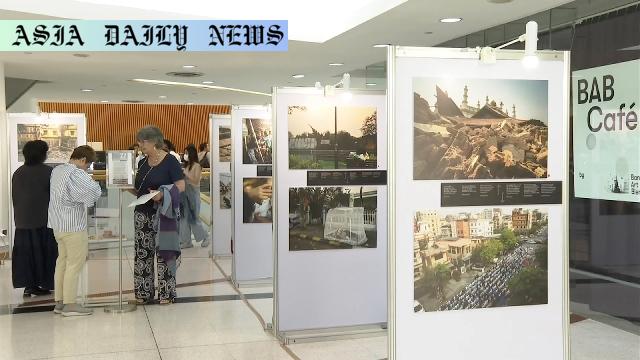Myanmar Quake: A photo exhibition in Bangkok sheds light on the devastation following the magnitude 7.7 earthquake in central Myanmar.
Key Point 1: The Bangkok exhibition showcases 40 impactful images from Myanmar’s March earthquake disaster.
Key Point 2: The quake, at a magnitude of 7.7, caused over 3,800 deaths, destroying homes and communities in central Myanmar.
Key Point 3: The exhibition emphasizes the resilience and suffering of survivors, urging continued global support.

The Devastating Impact of Myanmar’s Earthquake
The powerful earthquake that rocked central Myanmar in March left an indelible mark on thousands of lives. With a staggering magnitude of 7.7, it claimed over 3,800 lives, devastating communities and leaving survivors grappling with trauma and loss. The regions of Mandalay, Sagaing, and surrounding areas bore the brunt of the tragedy, enduring not only structural damage but also fires, homelessness, and displacement. This disaster exacerbates the challenges faced by a population already enduring years of conflict and instability.
In Mandalay, Myanmar’s second-largest city, the destruction was widespread. Over 400 buildings burned down after fires ignited by tremors swept through areas already rife with structural collapse. Families were left without homes, seeking refuge on the streets under makeshift shelters. The quake turned bustling neighborhoods into fields of rubble, erasing livelihoods, and leaving scars that recovery efforts will struggle to mend for years to come.
The Photo Exhibit – Capturing Tragedy and Resilience
In the heart of Bangkok, an extraordinary and heartfelt photo exhibition is drawing attention to this catastrophe. Featuring 40 compelling images taken by independent photojournalists and citizen reporters, the exhibition aims to bring the harrowing reality of this disaster to the forefront. Each photograph tells a deeply personal story of loss, survival, and resilience. From images depicting fiery destruction in Mandalay to street-side shelters under mosquito nets, these visuals highlight not just the material devastation but also the emotional toll on the people of Myanmar.
Visitors to the exhibit are moved not only by the sheer scale of damage but also by the humanity captured in these photos. One particularly poignant image shows a young family trying to navigate life amidst the debris, their resilience shining through in the face of immeasurable loss. These images underline the power of visual storytelling in fostering empathy and understanding, bridging cultural and geographical divides to remind us that the aftermath of tragedy is a shared concern for humanity.
Urgent Need for Support and Global Attention
Rosalia Sciortino, founder and executive director of SEA Junction, the organization behind the exhibition, emphasized the importance of not forgetting the plight of Myanmar’s earthquake victims. She expressed concern that the challenges faced by survivors have been overshadowed by other global events. Her message resonated with the attendees, many of whom remarked that seeing the photos evoked a much deeper emotional response than reading news articles or watching broadcasts.
While the exhibition has successfully highlighted the resilience of survivors, it also serves as a call to action. Sciortino and her team urge neighboring countries and the international community to provide continued support in rebuilding efforts. Financial aid, healthcare, and long-term rehabilitation programs are desperately needed to help families recover and reclaim their futures. Without sustained attention, they warn that Myanmar’s earthquake survivors may continue to suffer in silence.
Resilience Amidst Adversity
Despite the unimaginable losses, the resilience of the people of Myanmar shines through. Among all the devastation, stories of solidarity and courage abound. Communities have come together to provide each other with support, pooling resources and labor to clear debris and rebuild homes. Citizens and local organizations have stepped up to fill in the gaps left by strained governmental and international response mechanisms. These efforts are a testament to the indomitable human spirit.
As the photo exhibition in Bangkok illustrates, these survivors are more than victims—they are symbols of strength and determination. Through their struggles, they inspire us to reevaluate what truly matters: compassion, community, and the shared responsibility of aiding those in need.
Commentary
Power of Visual Storytelling
The photo exhibit in Bangkok serves as a poignant reminder of the immense power of visual storytelling. The 40 images showcased aren’t just photographs—they’re windows into the lives of those who faced unimaginable tragedy and loss. It’s one thing to read statistics about an earthquake’s destruction, but it’s an entirely different experience to see the raw emotion captured within these pictures. The despair, resilience, and humanity depicted compel viewers to reflect deeply and acknowledge their shared responsibility in addressing such crises.
Humanizing Tragedy
What makes this exhibition extraordinary is its ability to humanize a large-scale calamity. Beyond the thousands of lives lost and the infrastructures destroyed, it draws attention to individual lives—each photograph serves as a narrative of survival, defiance, and emotional endurance. These are not simply victims of a natural disaster; they are parents, children, workers, and dreamers struggling to rebuild their lives. By fostering this kind of connection, the exhibition highlights the value of empathy in a world often desensitized to tragedy.
A Call for Global Solidarity
The earthquake is not just a story of suffering—it’s a story of resilience and collective responsibility. Rosalia Sciortino’s call to action underscores the significance of international solidarity. Countries in the region, as well as the greater global community, must listen to these stories and provide tangible assistance. Recovery from a disaster of this scale requires ongoing support—be it financial, infrastructural, or psychological. Failure to act is a disservice to the resilience and courage displayed by the survivors.


